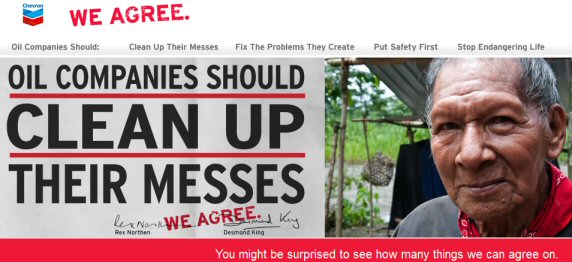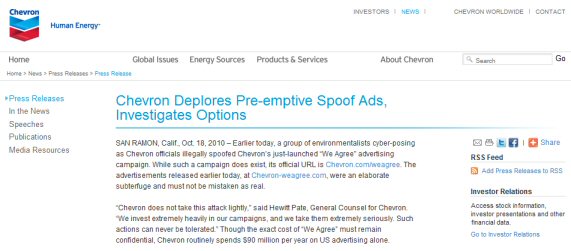After The Yes Men’s Chevron Spoof, What Next For YOU?
Posted by keith on October 26th, 2010
Strike while the iron is hot, or take a breather and think about your next move. The feelings of an Underminer during a hot spoof are often confused, but in some cases a retrospective look is necessary in order to understand what effective action really means. Case in point, the action by the Yes Men in undermining Chevron’s “We Agree” campaign, which for reasons Googley, I’m not going to link to.
At 07:37 BST (that’s 02:37 EST) an email popped into my mailbox purporting to come from Chevron Corp. Fortunately I was up at around this time, read the email, examined the headers, looked at the links and concluded it was a spoof: a very good spoof. Here’s the email:
From: Chevron Media Relations
Sent: Monday, October 18, 2010 7:37 AM
To: Keith Farnish
Subject: Radical Chevron Ad Campaign Highlights Victims
Chevron has added a news release to its Investor Relations website.
Title: Radical Chevron Ad Campaign Highlights Victims
Date(s): 18 October. 2010
To view this release on the web, please click here
Radical Chevron Ad Campaign Highlights Victims
By honestly featuring oil industry misdeeds, Chevron “We Agree” campaign scores ad industry first
SAN RAMON, Calif., Oct. 18, 2010 (BUSINESS WIRE) — Chevron Corp. (NYSE: CVX) has announced a new global advertising campaign aimed at showing Chevron as a “real people” corporation, and admitting to problems that companies usually try to hide.
“We want the world to know that we’re just like you and me,” said Chevron Vice Chairman George L. Kirkland. “We’ve got problems and challenges, and we too make mistakes, but we’re telling truths no one usually tells, and looking wide-eyed into the future.”
The candid advertising campaign, created by award-winning long-time Chevron ad partner McGarryBowen, features real people on the receiving end of Chevron controversies in Ecuador, Nigeria, the U.S. Gulf Coast and elsewhere. Each print ad is designed with an authentic pop-culture street-art aesthetic, and features a sincere slogan followed by a big red “We Agree” stamp, the signature of Chevron executives, and the Chevron logo.
“Chevron is making a clean break from the past by taking direct responsibility for our own actions,” said Rhonda Zygocki, Chevron vice president of Policy, Government and Public Affairs.
“Oil Companies Should Clean Up Their Messes,” reads one ad; the small print refers candidly to the damage done by oil companies around the world. “For decades, oil companies like ours have worked in disadvantaged areas, influencing policy in order to do there what we can’t do at home. It’s time this changed.”
Another ad, “Oil Companies Should Fix The Problems They Create,” is just as topical. “Extracting oil from the Earth is a risky process, and mistakes do happen. It’s easy to pass the blame or ignore the mistakes we’ve made. Instead, we need to face them head on, accept our financial and environmental responsibilities, and fund new technologies to avoid these mistakes in the future.”
“We were asked to show an agreeable, involved, of-the-people face for Chevron, and we think we came up with some really great ways of doing that,” said Gordon Bowen, Chief Creative Officer of McGarryBowen. “But what’s unique and different here is the honesty. We’ve never been able to do this before.”
“We’re telling truths no one usually tells,” said Zygocki. “We’re changing the way the whole industry speaks.”
“BP’s response to the Gulf tragedy was widely perceived as perfunctory and insincere,” noted Bowen. “Chevron has big problems too, like in Ecuador – but they’re really stepping up to the plate.”
The “We Agree” campaign is an evolution of Chevron’s “Power of Human Energy” campaign, which launched in 2007 with a series of print, online, broadcast and outdoor ads that all sought to raise awareness and encourage discussion about the major issues facing the energy industry. Though the exact cost of “We Agree” remains confidential, Chevron routinely spends $90 million per year on US advertising alone.
“‘We Agree’ conveys that Chevron is all for people,” said Zygocki. “Just as ‘We’ is inclusive, so Chevron is inclusive. It’s time we were on the side of people, no matter where those people are from.”
Chevron Corporation is one of the world’s leading integrated energy companies. The company has about 58,000 employees, and Chevron’s subsidiaries conduct business in approximately 180 countries. Chevron operates across the entire energy spectrum – exploring for, producing and transporting crude oil and natural gas; refining, marketing and distributing fuels and other energy products; generating power; designing and marketing large-scale energy efficiency solutions; and commercializing the energy resources of the future, including biofuels and other renewables. Chevron is based in San Ramon, Calif.
Please visit http://www.chevron-weagree.com for more on the “We Agree” campaign. More information about Chevron is available at http://www.chevron.com.
At this point, some people other than me were bound to have uncovered the ruse, but rather than making a big deal of it, I chose to keep quiet and let things take their course: what is the point of supporting something if you’re going to uncover it in public in the same breathe? I also wanted to think that this wasn’t the work of the Yes Men.
A strange sentiment? Well, after popping back a quick note to the originators…
That is very clever – don’t worry, I won’t tell. But if you need any help then let me know. Good mask on the domain names too.
K.
…I noticed that this bore far more of a resemblance to the kinds of spoofs that I have been discussing on my blogs, and even (ahem!) carrying out myself. I really wanted this to be from at least a Yes Men spin-off, if not a completely independent entity, because it would mean that the PR companies and corporate killers were starting to lose control of things.
Later on in the day, it was becoming clear that the Yes Men were being fingered with the spoof, the spoof itself (partly “thanks” to various smartarse bloggers) having been exposed fairly quickly. Following this exposure period something happened which gave new legs to the action – another press release from “Chevron”:
From: Chevron Corp.
Sent: Monday, October 18, 2010 5:45 PM
To: keith-farnish.plus.com
Subject: STATEMENT: Chevron Deplores Subterfuge, Investigates Options
Chevron has added a news release to its Investor Relations website.
Title: Chevron Deplores Subterfuge, Investigates Options
Date(s): 18 October. 2010
For a complete listing of our news releases, please click here
Chevron Deplores Subterfuge, Investigates Options
SAN RAMON, Calif., Oct. 18, 2010 (BUSINESS WIRE) — Earlier today, a group of environmentalists cyber-posing as Chevron officials illegally spoofed Chevron’s just-launched “We Agree” advertising campaign, confusing reporters (link). While such a campaign does exist, its official URL is Chevron.com/weagree. The advertisements released earlier today, at Chevron-weagree.com, were an elaborate subterfuge and must not be mistaken as real.
“Chevron does not take this attack lightly,” said Hewitt Pate, General Counsel for Chevron. “We invest extremely heavily in our campaigns, and we take them extremely seriously. Such actions can never be tolerated.” Though the exact cost of “We Agree” must remain confidential, Chevron routinely spends $90 million per year on US advertising alone.
Pate also noted that the environmentalists have made libellous allegations regarding Chevron’s record and obligations in Ecuador and beyond. “Despite what some will say, we are not obliged to abide by decisions that Ecuadorian judges make or do not make. This is because we have binding agreements with the Ecuadorian Government exempting us from any liabilities whatsoever, granted in exchange for a $40 million cleanup of some wells by Texaco in the 1990s.”
“We have always upheld the best values of every country to which we are attached,” added Pate.
“This hoax is part of an ongoing effort to blame Chevron for 18 billion gallons of toxic waste dumped in the Amazon during drilling operations,” said Rhonda Zygocki, Chevron vice president of Policy, Government and Public Affairs. “This blame game continues despite Chevron’s long-standing agreement with the Ecuadorian government which very obviously puts the issue behind us.”
For further information please visit Chevron’s official press page. For more information about Chevron please visit www.Chevron.com.
What was going on here was an attempt to inject some confusion into the story, by using a fake press release site to disseminate fake anger at a real spoof, while also adding fuel to the fire of Chevron’s abuses in South America.
Again, I fired off a quick response, and then kept schtum:
Oh, that’s wonderful. Slight coding error on the website (“stories” and “global issue”s toplinks are broken) but otherwise a brilliant bit of “heading them off at the pass” just as people realise it was a hoax. *I’m* not convinced you’re the Yes Men, though
Keith
I didn’t get a response, as responding in the affirmative is something you should never do when trying to cover your tracks, but they did fix the links – someone was on the ball here.
Someone at Business Week clearly wasn’t on the ball, as their article the next day clearly attests to. They may have been taken in by the further fakery related to Advertising Age, for not only was the Chevron site a fake, there was a fake AdAge web site to boot, something that is recorded in some detail by the real Advertising Age:
NEW YORK (AdAge.com) — First BP was targeted with a satirical Twitter feed, and now oil giant Chevron has been hit by pranksters hijacking its corporate-public-relations efforts. While the prank may go unnoticed by consumers, it does raise issues for both marketers and media.
The hoax that Chevron is now grappling with is far more elaborate and is timed to the launch of an ad campaign from the San Ramon, Calif.-based company and its lead agency, Dentsu-owned McGarryBowen.
Not only was a fake website created that parodied the real campaign, but fake press releases were sent out, including one posted to a site that looks remarkably similar to Chevron’s actual website. That release uses fake quotes by Rhonda Zygocki, Chevron’s VP-policy, government and public affairs, and Gordon Bowen, chief creative officer of McGarryBowen.
As part of the prank, there was even a fake story planted on a fake Ad Age site. Ad Age received calls Monday morning from someone purporting to be a Chevron spokesperson saying an erroneous story was posted to the AdAge.com. While the story looked real — the masthead and frames were swiped from a Marketer of the Year story posted to AdAge.com and the text was replaced with a Chevron story — the URL was a fake, one that misspelled the “advertising” in advertisingage.com (and there was no byline on the piece).
So that is that, it seems. The story has all but blown over and, with more irony that a professor of linguistics could muster, Chevron’s latest press release is trumpeting a new attempt at large-scale deepwater drilling in the Gulf of Mexico.
But that is not that!
It doesn’t take a computer genius or expert in public relations to dream up and execute something that could do great damage to a company or even an entire government; something I will be writing about at length in my new book. People who follow my writing may have come across this article on The Sietch a couple of years ago. You will have to take my word for it that at least three more spoofs have been carried out in three entirely different ways since then, with varying success.
And I am just one person.
What about you?






